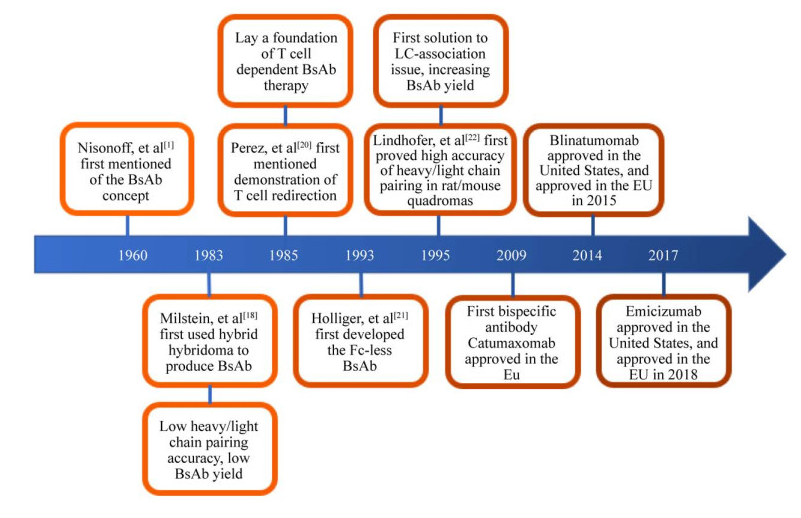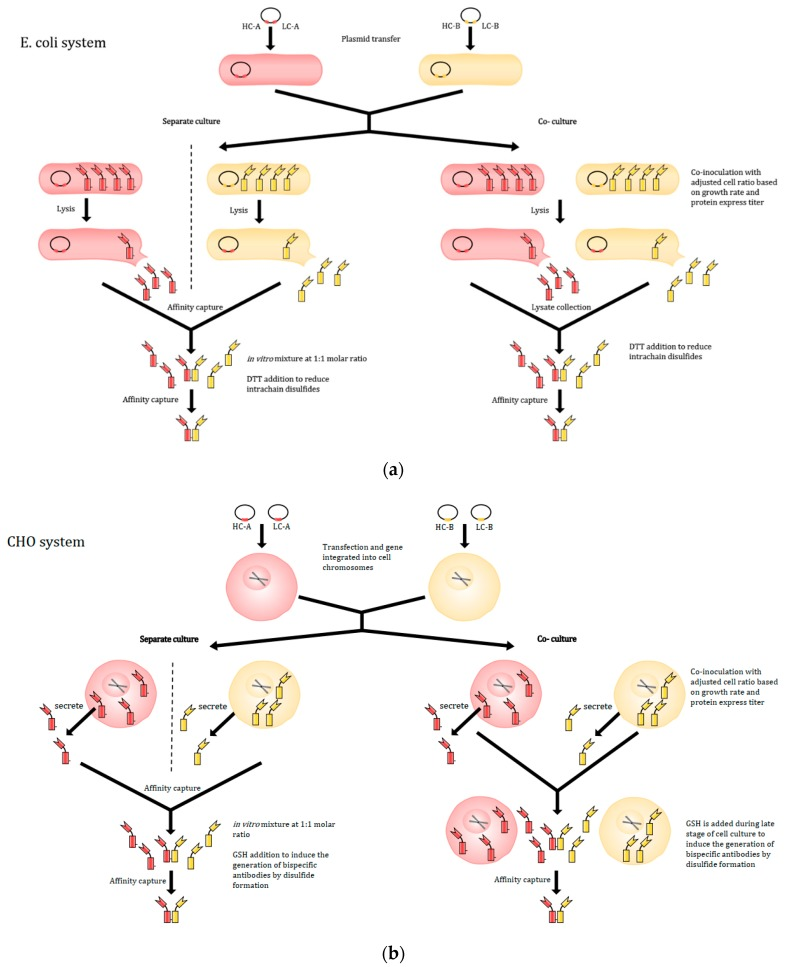2025-04-15 Hits(34)
Bispecific Antibody
Introduction of Bispecific Antibodies
Bispecial antibody can bind two different antigens at the same time. As an innovative biological therapeutic tool, its structural diversity and functional characteristics have attracted the attention of the academic community in the treatment of a variety of diseases, showing great research significance in the fields of cancer treatment, autoimmune diseases and infectious diseases. With the continuous progress of technology, The research and application prospect of bispecific antibody will be broader.
Bispecific antibodies are able to bind two or more antigens at the same time, improving the accuracy of treatment and reducing side effects by accurately distinguishing between malignant and normal cells. Bisspecific immune cell adhesives are particularly important because they can direct immune cells to the tumor, overcome immunosuppression in the tumor microenvironment, and restore anti-tumor activity.
Bispecial antibodies cannot be obtained from natural substances and can be produced using cell fusion or recombinant DNA techniques. The production of bispecific antibodies is a complex and technology-intensive process.

Figure 1:Research progress of bispecific antibody.
Structural Types of Bispecific Antibodies
Bispecific antibodies are mainly divided into: bispecific antibodies containing Fc region and those without Fc region.
(1) Bispecific antibody containing Fc region
Triomabs: Bind tumor cells and T cells respectively through Fv functional region, and recruit functional cells expressing FcR through Fc functional region.
Knobs-into-holes: By changing the amino acids in the CH3 region of the antibody heavy chain, a specific structure is formed to achieve the correct assembly between two different antibody heavy chains.
CrossMAb: bispecific antibody obtained by exchanging functional regions of the Fab arm.
DVD-Ig: The VL and VH of another antibody are connected to the N end of the light and heavy chains of normal antibody, respectively.
Two-in-one: Antibody modified by phage display technology.
(2) Bispecific antibodies without Fc region
SDA (Single domain Antibody) : An antibody consisting only of heavy chains.
Fv: Variable region fragment consisting of two polypeptide chains.
scFv (Single chain Antibody) : An antibody consisting of the variable regions of the heavy and light chains of the antibody connected by linkers [4].
Fab: The first constant and variable region of an antibody.
scFab: Single chain antibody and Fab combined structure.
Bispecific Antibody Production
The production methods of bispecific antibody mainly include double hybridoma fusion and genetic engineering.
Quadroma technology, which expresses specific mouse IgG through the fusion of two different hybridoma cell lines, is an earlier technology for the production of bisspecific antibodies and an early preparation method. However, the true percentage of functional bispecies is unpredictable and requires a complex process to separate bispecies from by-products, with the problem of a low proportion of functional bispecies. To improve quality and yield, various strategies have been developed, such as the Knobs-into-holes technique, which promotes the correct assembly of two different antibody heavy chains by making mutations at specific locations in the CH3 region of the antibody heavy chain.
Using molecular cloning technology, it is possible to assemble bisspecific IgG antibodies expressing two different heavy and light chains from the same cell. Generally, HC and LC are expressed on different plasmids because controlling the plasmid ratio is a simple and effective way to optimize the assembly of the desired product protein. The expression of recombinant antibody can be used for the design and construction of double antibody, and the expression and purification of bisspecific antibody can be performed instantaneously by transfecting cells with recombinant plasmid.
The common production steps of recombinant antibody expression are as follows:
(1) Antibody gene synthesis and subcloning: design and synthesize the target DNA sequence. The complete sequence was subcloned into a proprietary vector for expression.
(2) Antibody cell culture and transient transfection: cells are grown in serum-free medium. Recombinant plasmids encoding H and L chains were transient co-transfected into suspension cell cultures. Cell culture supernatants were collected for SDS-PAGE analysis on day 5 after transfection to assess expression levels.
(3) Antibody purification and analysis: Protein A column is used for purification. The eluted fractionation is analyzed by SDS-PAGE and Western blot, and finally mixed and buffer exchanged to the final storage buffer.

Figure 2:Schematic diagram of production of IgG bispecific antibodies by E. coli and CHO systems[4]
Clinical Application of Bispecific Antibody
Bispecific antibodies have broad application prospects in the treatment of tumor and autoimmune diseases, and with the continuous advancement of technology and the advancement of clinical trials, these antibodies are expected to provide new treatment options for more patients.
Bispecific antibody therapy have made remarkable progress in the treatment of blood tumors. For example, Blinatumomab, a bispecific antibody that targets CD3 and CD19, has been used to treat some types of leukemia. Other bisspecific antibodies in development also show potential in the treatment of blood tumors by binding the surface antigens of tumor cells and immune cells (such as T cells or NK cells) to activate the killing of tumor cells by immune cells.
In the treatment of solid tumors, bispecific antibodies also show a good application prospect. For example, some bisspecific antibodies activate an immune response or block tumor growth signals by simultaneously binding to two different antigens on the surface of tumor cells, or by binding to antigens on the surface of tumor cells and immune cells. These antibodies can recruit and activate immune cells more effectively and improve the efficacy of anti-tumor therapy.
Bispecific antibodies also show potential in the treatment of autoimmune diseases. For example, some bispecial antibodies target both inflammatory mediators and receptors on immune cells in the hope of achieving better anti-inflammatory effects. These antibodies are able to selectively modify the signaling of disease-causing immune cell types, thereby reducing the inflammatory response.Bispecific antibodies have also shown potential in the treatment of diabetes, HIV infection, Alzheimer's disease, osteoporosis and other diseases.
FDA Approved Bispecific Antibody
The U.S. Food and Drug Administration (FDA) has approved a variety of bisspecific antibodies (BSABs) for the treatment of different diseases. The following are some of the approved bispecific antibodies:
|
Antibody Name |
Trade name | Mechanism of action | Function |
| Blinatumomab | Blincyto | Target CD3 and CD19 for T-cell-mediated killing. | For acute lymphoblastic leukemia (ALL) |
| Emicizumab | Hemlibra | Target the clotting factors IXa and X, mimicking the function of the clotting factor VIIIa. | For hemophilia A |
| Amivantamab | Rybrevant | Target EGFR and c-Met for NSCLC patients with EGFR mutations. | For non-small cell lung cancer (NSCLC) |
| Tebentafusp-tebn | Kimmtrak | Target gp100 and CD3 for the treatment of metastatic uveal melanoma. | For uveal melanoma |
| Faricimab-svoa | Eylea | Targeted VEGF-A and VEGF-P for eye diseases. | For wet age-related macular degeneration (wet AMD) and diabetic retinopathy (DME) |
| Mosunetuzumab | Lunsumio | Targeting CD20 and CD3 for T-cell-mediated killing. | For relapsed or refractory follicular lymphoma (FL) |
| Epcoritamab | Epkinly | Target CD3 and CD20 for T-cell-mediated killing. | For relapsed or refractory diffuse large B-cell lymphoma (DLBCL) |
Bispecific Antibody FAQs
Q1: What is the mechanism of action of bispecific antibodies?
A: (1) Mediated immune cell killing: By binding to target cells and immune effector cells (such as T cells), effector cells are guided to target and kill tumor cells.
(2) Block dual signaling pathways: Bind two targets at the same time to block signaling pathways, thereby inhibiting the growth and spread of tumor cells.
(3) Promotes antigen presentation: Enhances the immune response by binding antigens to antigen-presenting cells.
Q2: What are the clinical applications of bispecific antibodies?
A: Bisspecific antibodies have potential applications in the treatment of a variety of diseases, for example, by targeting tumor cells and T cells, directing T cells to kill tumor cells. Alleviating disease symptoms by blocking abnormal immune responses.
Q3: What are the advantages of bispecific antibodies?
A: Compared with traditional monoclonal antibodies, bispecific antibodies have higher selectivity and can combine two different targets at the same time to improve the accuracy of treatment. By dual targeting, the immune response can be enhanced and the therapeutic effect can be improved. By combining multiple targets, the occurrence of drug resistance is reduced.
Q4: What is the future direction of bispecific antibodies?
A: Bispecific antibodies will continue to explore new indications and mechanisms of action in future development, including more tumor types and rare diseases
References
[1] Nisonoff A, Wissler FC, Lipman LN. Properties of the major component of a peptic digest of rabbit antibody. Science, 1960, 132(3441): 1770-1771. DOI:10.1126/science.132.3441.1770
[2] Nutt NB, Grossberg AL, Pressman D. Raised bispecific anti-p-azophenylphosphorylcholine antibodies reactive with nitroiodohydroxyphenylacetyl. Immunochemistry, 1976, 13(7): 559-564. DOI:10.1016/0019-2791(76)90166-X
[3] Bray F, Ferlay J, Soerjomataram I, et al. Global cancer statistics 2018: GLOBOCAN estimates of incidence and mortality worldwide for 36 cancers in 185 countries. CA Cancer J Clin, 2018, 68(6): 394-424. DOI:10.3322/caac.21492
[4] Wang Q, Chen Y, Park J, et al. Design and Production of Bispecific Antibodies[J]. 2019.